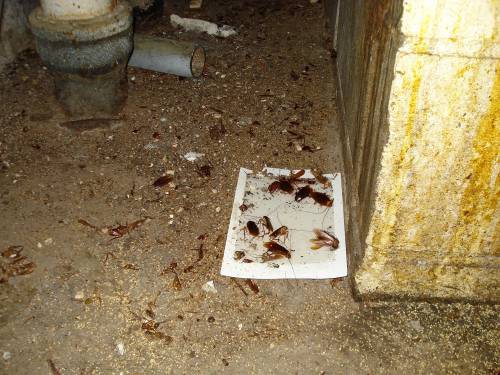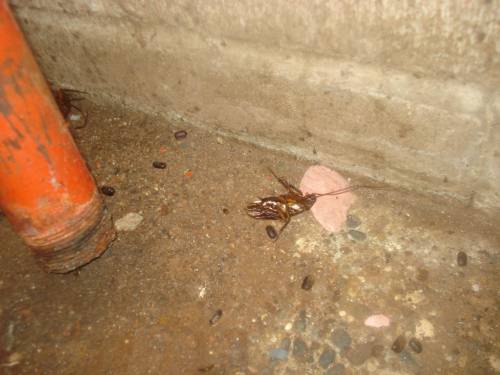American Cockroach Management: Practical Strategies And Solutions
 Cite
Cite
Abstract
The American cockroach (*Periplaneta americana*) is not just a household pest; it possesses remarkable resilience and intriguing biological characteristics. Although a well-known urban pest, research has found potentially useful anti-bacterial proteins inside American cockroach's hemolymph. However, it's crucial to recognize their primary status as significant public health pests. Their remarkable ability to locate food sources, coupled with their capacity to live, breed, and thrive in sewers, underscores the necessity for applying Integrated Pest Management (IPM) strategies.
Identification
The American cockroach is large, measuring approximately 1.5 inches (3.8 cm) in length, characterized by its reddish-brown body and elongated antennae. Both adult males and females possess wings, with the female's wings covering its body and the male's extending beyond it. An identifying feature is the distinct yellowish figure-eight pattern found on its pronotum, situated at the upper surface of the first thoracic segment (pronotum). Compared to German cockroaches, American cockroaches are larger, darker in color, and lack the longitudinal stripes on the pronotum. Oriental cockroaches share similarities but exhibit a less intense reddish hue and lack the yellow hollow figure-eight pattern on the pronotum. Recognizing these features is essential for accurate identification and choosing effective management.
Management
Effective long-term solutions for American cockroaches rely on IPM strategies, particularly due to the escalating issue of pesticide resistance. As American cockroaches develop resistance to traditional pesticides, solely relying on chemical methods proves less effective over time. IPM can combine both chemical and non-chemical methods to prevent and combat pesticide resistance and efficiently address cockroach infestations. Moreover, the increasing demand for environmentally friendly solutions requires embracing IPM practices more than ever.
1) Chemical Management Methods
Effective management of American cockroaches in sewer systems is necessary to prevent their spread and infestation of neighboring structures (Rust et al., 1991). Rust et al. (1991)conducted a comprehensive study evaluating various pesticide formulations, including sprays, baits, and dust formulations, against American cockroaches. They found that microencapsulated chlorpyrifos and diazinon sprays were highly effective, providing control for up to nine months and achieving reductions exceeding 94% for a year. However, despite their effectiveness, both chlorpyrifos and diazinon have been banned in the USA due to their adverse impacts on public health and ecological systems. Conversely, baits containing boric acid and hydramethylnon showed inconsistency due to issues such as mold and depletion by cockroach populations. On the other hand, treatments utilizing boric acid powder and a powder mixture of silica gel + synergized pyrethrins demonstrated effectiveness for at least one month. Expanding on the aforementioned findings, Zahraei-Ramazani and colleagues (2018) conducted a study evaluating insecticides for controlling American cockroaches in the sewage system. The results indicated that products such as chlorpyrifos 5% EC, diazinon 5% EC, diazinon 0.05% EC, and cypermethrin 5% fog achieved over 90% cockroach control for five months. This highlights their effectiveness in managing infestations in similar environments.
Furthermore, Bueno-Marí et al. (2013) conducted assays in the municipal sewerage system of Valencia, Spain, and found that paints, with or without insecticide, were the most effective in reducing cockroach populations for up to three months. This finding suggests that paint alone can serve as an effective physical barrier against cockroach infestation. Additionally, a product combining two pyrethroids with piperonyl butoxide showed promising results for one month, while organophosphate insecticides only reduced cockroaches for one week. The study concluded that Insect Growth Regulators (IGRs) were ineffective for controlling cockroaches in sewers. These findings highlight the importance of selecting the appropriate chemical control methods for effective cockroach management in sewer environments.
If baits are used, strategic placement is essential for successful cockroach control. In sewer environments, maintaining bait integrity in manholes is critical to prevent contamination and ensure bait consumption. In residential areas, baits should be strategically placed in areas frequented by cockroaches, such as near walls, inside voids, and in cracks. For instance, studies have shown that baits containing indoxacarb and hydramethylnon are effective in targeting American cockroach populations in kitchens and residential units (Anikwe et al., 2014; Milio et al., 1986)
Moreover, the utilization of granular insecticide baits offers a convenient and versatile approach to managing various insects, including American cockroaches. Although American cockroaches primarily inhabit sewers, they frequently visit yards, streets, and areas near water bodies. Thus, applying granular insecticide baits in outdoor areas while adhering to product label instructions, can effectively diminish their presence and mitigate their encroachment into human-inhabited spaces. This is particularly important when other formulations of baits may not be practical or safe to use.
Since Norway rats also inhabit sewers, where rodenticide baits are commonly used, there is a risk that American cockroaches may consume the rodent baits which will render any rodent control treatment ineffective. It's important to note that rodenticides do not target cockroaches and are not effective in controlling their populations. Therefore, relying solely on rodenticides for pest management in sewers will not address the issue of American cockroach infestations. Instead, implementing targeted strategies to eliminate cockroaches from sewer systems is essential to prevent interference with rodent management efforts and ensure effective pest control. Alternatively, relying on mechanical traps for rat control until the cockroach infestation is eliminated from the sewer may be a more effective approach. Otherwise, rodenticides may serve as an additional food source for American cockroaches, exacerbating the existing pest control issues.
2) Non-Chemical Management Methods
Besides chemical management methods, non-chemical approaches can complement or augment cockroach management efforts. These methods may include biological control using parasitic wasps, trap seals, glue traps, and sanitation coupled with habitat modification. Biological control of American cockroaches using parasitic wasps like Evania appendigaster, as suggested by Hwang and Chen (2004), is a promising approach. Combining oothecal parasitism with baiting methods could effectively reduce these cockroach populations, particularly in environments like sewer networks, offering sustainable and comprehensive pest control solutions.
Another non-chemical method is cockroach exclusion using trap seals. A trap seal is a mechanical device installed on drains that allows water to pass through but prevents gasses and pests from reaching indoor spaces. Innovative tools like the Green Drain GD3 3" waterless trap seal offer alternative non-chemical solutions for managing cockroach populations in drains. These environmentally friendly options complement traditional approaches, contributing to sustainable pest control practices. However, the practical use of these devices requires thorough field tests to evaluate efficacy. Sanitation can also help in managing American cockroach infestations indoors. Sanitation involves keeping areas clean and free of food debris, which removes potential food sources for cockroaches and discourages their presence.
Conclusion
Integrating both chemical and non-chemical methods is essential for long-term American cockroach management. Exclusion techniques, chemical treatments of sewer, and strategic bait placement can significantly reduce American cockroach pressure in and around buildings. Alternative approaches like biological control and sanitation can improve and extend American cockroach management in diverse environments, including sewers, streets, and buildings.
References
-
Anikwe, J. C., F. A. Adetoro, J. A. Anogwih, W. A. Makanjuola, K. A. Kemabonta, and K. L. Akinwande. 2014. "Laboratory and Field Evaluation of an Indoxacarb Gel Bait Against Two Cockroach Species in Lagos, Nigeria." Journal of Economic Entomology 107 (4): 1639–42.
-
Basseri, H. R., A. Dadi-Khoeni, R. Bakhtiari, M. Abolhassani, and R. Hajihosseini-Baghdadabadi. 2016. "Isolation and Purification of an Antibacterial Protein from Immune Induced Haemolymph of American Cockroach, Periplaneta Americana." J Arthropod Borne Dis 10 (4): 519–27.
-
Bueno-Marí, R., A. Bernués-Bañeres, F. J. Peris-Felipo, J. Moreno-Marí, and R. Jiménez-Peydró. 2013. "American Cockroach Control Assays in the Municipal Sewerage System of Valencia (Spain)." Polish Journal of Entomology 82 (3): 143.
-
Hwang, S. Y., and L. M. Chen. 2004. "Effects of Four Physical Treatments of Oothecae of Periplaneta Americana on Parasitism and Development of Parasitic Wasp Evania Appendigaster." Environmental Entomology 33 (5): 1321–26.
-
Milio, J. F., P. G. Koehler, and R. S. Patterson. 1986. "Laboratory and Field Evaluations of Hydramethylnon Bait Formulations for Control of American and German Cockroaches." Journal of Economic Entomology 79 (5): 1280–86.
-
Rust, M. K., D. A. Reierson, and K. H. Hansgen. 1991. "Control of American Cockroaches (Dictyoptera: Blattidae) in Sewers." J Med Entomol 28 (2): 210–13.
-
Zahraei-Ramazani, A. R., A. Saghafipour, and H. Vatandoost. 2018. "Control of American Cockroach (Periplaneta Americana) in Municipal Sewage Disposal System, Central Iran." Journal of Arthropod-Borne Diseases 12 (2): 172–79.



